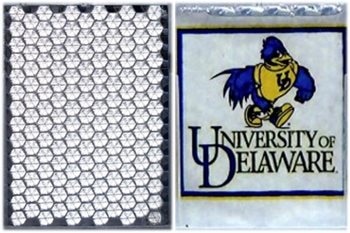Dec 14 2017
Prototype windows capable of switching from reflective to clear with the simple incorporation of a liquid were demonstrated by researchers. The new switchable windows are easy to make and could make office buildings more energy efficient or soon keep parked cars cool in the sun. The technology can also be applied to build roof panels that keep houses warm in the winter and cool in the summer.
 Researchers created a prototype smart glass that is retroreflective (left) and becomes clear (right) when a liquid with optical properties similar to the reflective structure is pumped into a chamber in front of the structure. (Image Credit: Keith Goossen, University of Delaware)
Researchers created a prototype smart glass that is retroreflective (left) and becomes clear (right) when a liquid with optical properties similar to the reflective structure is pumped into a chamber in front of the structure. (Image Credit: Keith Goossen, University of Delaware)
Although glass that uses an applied voltage to shift from clear to a tinted or opaque state is commercially available, its high cost of about $100 per square foot has delayed widespread use.
We expect our smart glass to cost one tenth of what current smart glass costs because our version can be manufactured with the same methods used to make many plastic parts and does not require complicated electro-optic technology for switching.
Keith Goossen, Co-leader of the research team, The University of Delaware
The new smart windows have a plastic panel with a design of structures that is retroreflective. This means that instead of reflecting light in all directions like a mirror, it reflects light back in the direction it came from like a bicycle reflector.
In The Optical Society (OSA) journal Optics Express, the researchers showcase a prototype of the new smart glass consisting of a 3D printed plastic panel covered by a thin chamber. When the chamber is filled with the fluid methyl salicylate — which matches the plastic’s optical properties — the retroreflective structures turn transparent.
“Although we had to develop new ways to process 3D printable plastics with good optical performance, develop inexpensive refractive index-matching fluids and come up with highly reflective optical structures, the innovation here is mostly in recognizing that such a simple concept could work,” said Goossen.
Keeping cars cool
One of the most potential applications for the new switchable glass may be in cars, where it could be employed to modify the windshield to a reflective state when the car is parked in the hot sun.
“You can’t use today’s commercially available switchable glass for this application because in the darkened state the windshield still absorbs sunlight and becomes hot,” said Goossen. “Because our glass is retroreflective in the non-transparent state, almost all the light is reflected, keeping the glass, and thus the car, from getting hot.”
The fact that the glass is retroreflective means that if it were used on the outer side of a skyscraper, for instance, it would direct light upwards to the sun instead of downwards to the street. This decreases the building’s role in city warming, which is an issue in many urban areas.
The researchers have also demonstrated that the plastic retroreflective panels can be employed as an economical switchable roofing structure that lowers heating and cooling costs. In places that are warm and sunny throughout the year, white roofing materials have been revealed to lower cooling costs by reflecting sunlight. However, in place with cold winters, these white roofs prohibitively increase heating costs in the winter.
Here in Delaware, you would like to have a white roof in the summer to keep the house cool and a dark roof in the winter to absorb sunlight and help lower heating costs. For smart roofing, our new technology offers a more effective type of cool roof because it is retroreflective while also allowing the roof to switch to dark in the winter.
Keith Goossen
For roofing applications, a layer of material positioned under the panels is used to capture light when the panels are in their clear state. This helps keep the house warmer when the temperatures outside are cold. Although the methyl salicylate used in the prototype could freeze in extremely cold climates (less than 16 °F), freeze-resistant fluids could be created.
3D printing the prototype
To create the new switchable glass, the researchers began by using 3D printing to create plastic panels with repeating retroreflective structures of many sizes for testing. They used a commercially available clear 3D printable material and created post-processing steps to guarantee the plastic stayed extremely transparent after printing and showed very accurate corners, which were vital to realize retroreflection.
Without 3D printing, we would have had to use a molding technology, which requires building a different mold for every different structure. With 3D printing, we could easily make whatever structure we wanted and then run experiments to see how it performed. For commercial production, we can use standard injection molding to inexpensively make the retroreflective panels.
Keith Goossen
Once the researchers found out the ideal size to use for the repeating structures, they did optical testing to establish whether characteristics such as surface roughness or the material’s light absorption would cause unanticipated optical problems. These optical tests revealed that the structures functioned precisely as specified by optical simulations.
“Importantly, we also demonstrated that the device can undergo thousands of cycles from transparent to reflective without any degradation,” said Goossen. They did, however, discover that some fluid remains on the structure rather than draining off. To solve this matter, the researchers are designing coatings that will help the fluid drain off the plastic without leaving any residue.
“To further demonstrate the technology’s usefulness as switchable glass, we are building an office door that incorporates the new smart glass as a switchable privacy panel,” said Goossen. “These types of panels are currently made with much more expensive technology. We hope that our approach can broaden this and other applications of smart glass.”